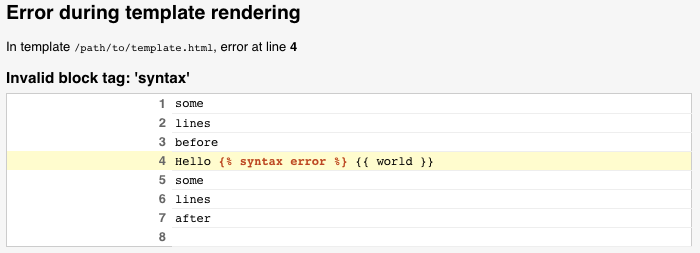如何实现自定义模板后台¶
自定义后台¶
以下是如何实现自定义模板后台以使用另一个模板系统。模板后台是继承的类 django.template.backends.base.BaseEngine .它必须实现 get_template() 并且可选地 from_string() .这是一个虚构的例子 foobar 模板库::
from django.template import TemplateDoesNotExist, TemplateSyntaxError
from django.template.backends.base import BaseEngine
from django.template.backends.utils import csrf_input_lazy, csrf_token_lazy
import foobar
class FooBar(BaseEngine):
# Name of the subdirectory containing the templates for this engine
# inside an installed application.
app_dirname = "foobar"
def __init__(self, params):
params = params.copy()
options = params.pop("OPTIONS").copy()
super().__init__(params)
self.engine = foobar.Engine(**options)
def from_string(self, template_code):
try:
return Template(self.engine.from_string(template_code))
except foobar.TemplateCompilationFailed as exc:
raise TemplateSyntaxError(exc.args)
def get_template(self, template_name):
try:
return Template(self.engine.get_template(template_name))
except foobar.TemplateNotFound as exc:
raise TemplateDoesNotExist(exc.args, backend=self)
except foobar.TemplateCompilationFailed as exc:
raise TemplateSyntaxError(exc.args)
class Template:
def __init__(self, template):
self.template = template
def render(self, context=None, request=None):
if context is None:
context = {}
if request is not None:
context["request"] = request
context["csrf_input"] = csrf_input_lazy(request)
context["csrf_token"] = csrf_token_lazy(request)
return self.template.render(context)
看见 DEP 182 以获取更多信息。
定制引擎的收件箱集成¶
Django调试页面具有挂钩,可以在出现模板错误时提供详细信息。自定义模板引擎可以使用这些挂钩来增强向用户显示的追溯信息。提供以下挂钩:
模板尸检¶
尸检出现时 TemplateDoesNotExist 被提出。它列出了尝试查找给定模板时使用的模板引擎和加载器。例如,如果配置了两个Django引擎,则事后分析将显示为:

自定义引擎可以通过传递 backend 和 tried 提出时的争论 TemplateDoesNotExist .使用尸检的后台 should specify an origin 在模板对象上。
上下文线路信息¶
如果模板解析或渲染过程中发生错误,Django可以显示发生错误的行。例如:

自定义引擎可以通过设置 template_debug 解析和呈现期间引发的异常的属性。此属性是 dict 具有以下值:
'name':发生异常的模板的名称。'message':异常消息。'source_lines':之前、之后的行以及包括发生异常的行。这是针对上下文的,因此它不应该包含超过20行左右。'line':发生异常的线路号。'before':引发错误的令牌之前的错误行上的内容。'during':引发错误的令牌。'after':引发错误的令牌之后的错误行上的内容。'total':中的行数source_lines。'top':其中的线路号source_lines开始。'bottom':其中的线路号source_lines形接头.
鉴于上述模板错误, template_debug 看起来像::
{
"name": "/path/to/template.html",
"message": "Invalid block tag: 'syntax'",
"source_lines": [
(1, "some\n"),
(2, "lines\n"),
(3, "before\n"),
(4, "Hello {% syntax error %} {{ world }}\n"),
(5, "some\n"),
(6, "lines\n"),
(7, "after\n"),
(8, ""),
],
"line": 4,
"before": "Hello ",
"during": "{% syntax error %}",
"after": " {{ world }}\n",
"total": 9,
"bottom": 9,
"top": 1,
}
Origin API和第三方集成¶
Django模板有 Origin 可通过 template.origin 属性这使得调试信息能够显示在 template postmortem ,以及第三方图书馆,例如 Django Debug Toolbar .
定制引擎可以提供自己的 template.origin 通过创建指定以下属性的对象来获取信息:
'name':模板的完整路径。'template_name':传递到模板加载方法中的模板的相对路径。'loader_name':一个可选字符串,标识用于加载模板的函数或类,例如django.template.loaders.filesystem.Loader。
Last update:
5月 28, 2025